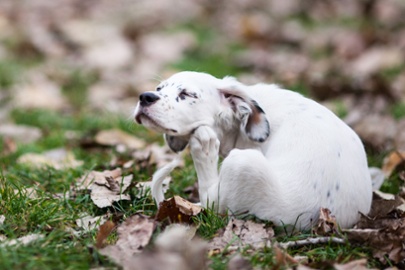 More than just annoying insects, fleas are the leading cause of itchiness and skin irritation in dogs. Aside from potentially causing extreme irritation and skin damage, fleas can also carry and transmit a number of potentially serious diseases in dogs, such as tapeworm.
More than just annoying insects, fleas are the leading cause of itchiness and skin irritation in dogs. Aside from potentially causing extreme irritation and skin damage, fleas can also carry and transmit a number of potentially serious diseases in dogs, such as tapeworm.
Dogs which are fed a nutritious, whole food based diet are more likely to be healthy both inside and out when compared with dogs which eat an unhealthy, highly processed diet. Plus, the daily addition of Dig-In Digestive Gravy Powder to your dog’s meal, will help to further boost your dog’s immune system, improve the condition of their skin, and reduce the risk of a parasite infestation.
Dogs often become infested with fleas through contact with other animals or with fleas in the environment. The strong back legs of adult fleas enable them to jump easily from host to host or from the environment onto a passing animal. Flea eggs can be equally problematic, with the potential to lie dormant in your house or garden for long periods of time, until they are able to hitch a ride from a suitable host. An awareness of the signs and symptoms of fleas will help to keep your dog and your home a healthy, flea-free environment.
Symptoms
If your dog has fleas you may observe one or more of the following symptoms:
- Droppings or “flea dirt” in your dog’s coat (which look like tiny flecks of black pepper)
- Excessive scratching, licking or biting at skin
- Patchy areas of hair loss
- Skin abrasions and hot spots
- Pale gums
- Restlessness
- Tapeworm segments on or around the backside or in faeces
Regular grooming gives you the opportunity to inspect your dog for fleas – they are dark brown, flat-bodied and can be most often found on your dog’s abdomen, neck and the lower back at the base of the tail. If you notice any potential symptoms or signs of fleas on your dog, your vet will be able to confirm the diagnosis and rule out other skin allergies which can have similar symptoms.
Treatment
Adult fleas will continue to reproduce and thrive on your dog and in your home until you break the cycle. It’s important to take a combined approach to treatment by using a preventative medication on your dog and regularly cleaning the areas of your home that your dog frequents:
- On your dog. Normally applied once a month, topical ‘spot on’ treatments are very effective at killing adult fleas and eggs, with some products also multi-tasking as heartworm or intestinal worm treatments.
- In your home. Keeping your dog’s living environment clean helps to prevent flea outbreaks. This includes vacuuming regularly (particularly in areas where your pet sleeps), and regularly washing your dog’s bedding.
The heat and humidity in Australia (which is an ideal environment for fleas), means that preventative flea treatments must be continued throughout the year – not just in spring and summer. Not all flea treatment products are created equal, so be sure to discuss the best flea treatment plan with your vet to help ensure a flea-free future for you and your dog!






